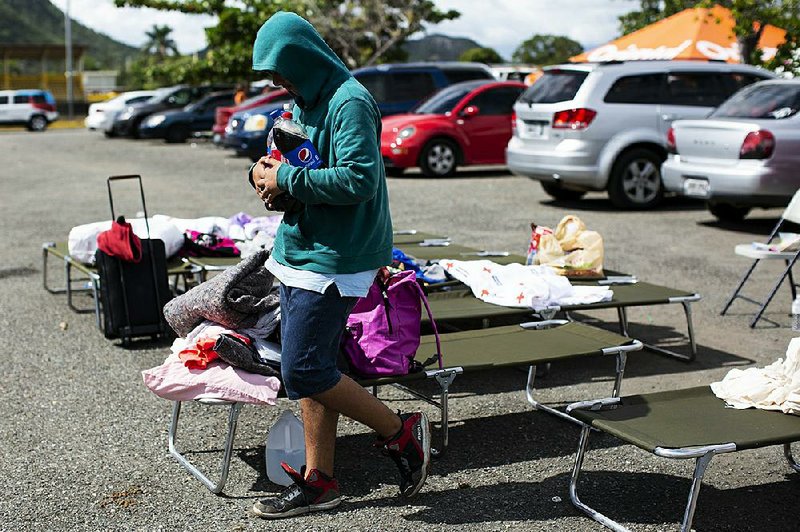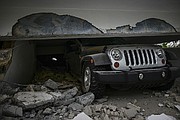GUANICA, Puerto Rico -- Cars, cots and plastic chairs became temporary beds for hundreds of families who lost their homes in southwest Puerto Rico as a flurry of earthquakes struck the island, one of them the strongest in a century.
The magnitude-6.4 quake that struck before dawn Tuesday killed one person, injured nine others and knocked out power across the U.S. territory. More than 250,000 Puerto Ricans remained without water on Wednesday and another half a million were without power, which also affected telecommunications.
Another strong aftershock, this one at magnitude 4.7, struck Wednesday near the island's southern coast at the same shallow depth as Tuesday's earthquake. No serious damage was immediately reported.
More than 2,000 people were staying in government shelters in the island's southwest region as President Donald Trump declared an emergency and Puerto Rican Gov. Wanda Vazquez activated the National Guard.
[Video not showing up above? Click here to watch » https://www.youtube.com/watch?v=7MbqAENn6AQ]
"The magnitude of this event is so serious that the state government and the municipal governments of Puerto Rico do not have the capacity to respond effectively," she said as she praised Trump's decision.
The quake on Tuesday caused serious damage to one of Puerto Rico's major power plants, Costa Sur, which generates about 40% of the island's electricity.
Vazquez gave government workers the day off Wednesday and urged everyone to stay home to "avoid chaos." Most traffic lights were not working.
"This is an event we have never lived through before," the governor said. "We were not prepared for this. There is no way to prepare for this. It hit us hard, hard, hard."
The governor said she and other senior officials traveled to the Costa Sur plant to check conditions after the series of earthquakes that has shaken the island since late December. "We were able to verify that it suffered severe damage to the infrastructure, to the point that employees were injured," she said at a news conference Tuesday night.
A wall fell on an employee, who was hospitalized in stable condition, Vazquez said. Officials said the damage to the plant was so bad that it may be beyond repair. Engineers may instead decide to focus on another power plant, which has received federal funding for improvements.
Jose Ortiz, chief executive of the Puerto Rico Electric Power Authority, said he hoped to get everyone's power back on in the next day or so. He stressed that service would be restored gradually in order to avoid overloading an unstable system.
"We learned from the mistakes of the past," he said. "We want to do it little by little so that those who get their service back, keep their service."
[Gallery not loading above? Click here for more photos » arkansasonline.com/19quake/]
Eli Diaz, president of the agency, told WKAQ radio that authorities were scrambling to find generators to power the water plants but were finding that some of the equipment that had been tested before the earthquakes did not work when needed.
"This is a question of hygiene and health," Diaz said. "People can go without water for one day, maybe two. Now is when things start getting a little harder."
The hardest-hit municipality was the southwest coastal town of Guanica. More than 200 people had taken shelter in a gymnasium after a quake on Monday, only for the latest temblor to damage that structure -- forcing them to sleep outside.
Among them was 80-year-old Lupita Martinez, who sat in the dusty parking lot with her 96-year-old husband by her side. He was sleeping in a makeshift bed, a dark blue coat covering him.
"There's no power. There's no water. There is nothing. This is horrible," Martinez said.
The couple were alone, lamenting that their caretaker had disappeared and was not answering their calls. Like many Puerto Ricans affected by the quake, they have children in the U.S. mainland who urged them to move there, at least until the earth stops shaking.
While officials said it was too early to estimate the total damage caused by the string of quakes that began the night of Dec. 28, they said hundreds of homes and businesses in the southwest region were damaged or destroyed. In Guanica, a town of roughly 15,000 people, nearly 150 homes were affected by the quake. Three schools in the town were affected, including a three-story structure where the first two floors were completely flattened.
In Guanica, "We are confronting a crisis worse than Hurricane Maria," said Mayor Santos Seda, referring to the 2017 storm that devastated the island. "I am asking for empathy from the federal government."
He said officials believe that the homes of 700 families in his municipality are close to collapsing.
Tuesday's earthquake was the strongest to hit Puerto Rico since October 1918, when a magnitude-7.3 quake struck near the island's northwest coast, unleashing a tsunami and killing 116 people.
More than 950 quakes and aftershocks have been recorded in the area of Tuesday's event since Dec. 31, though most were too weak to be felt, according to the U.S. Geological Survey.
The U.S. Geological Survey said that while it's virtually certain there will be many aftershocks in the next week, the chance of a magnitude-6 quake -- similar to Tuesday's -- or stronger is around 22%.
In Guanica, some people dragged mattresses outside their homes or set up small tents.
Authorities were trying to figure out where to shelter them all as they handed out blankets, food and water to families gathered at the gymnasium site for a second night in a row. Many had their belongings in large garbage bags as they sat on unstable plastic chairs. Some slept. Others cradled their dogs, and many simply stared into the distance. One elderly man spent an entire day in his wheelchair, refusing to lay down on a cot.
Meanwhile, a handful of people slept in their cars, in chairs or on the ground as cots ran out.
"Now I'm afraid of the house," 49-year-old Lourdes Guilbe said as she wiped away tears and confided that she felt overwhelmed caring for the nearly dozen relatives gathered around her, including her 90-year-old grandfather, who sat in a wheelchair while wearing green pajamas and socks.
Guilbe said her home is cracked and that her daughter's home collapsed, so they weren't sure where they would live in the coming days.
Psychologists met with Guilbe and dozens of other people affected by the earthquakes, going door to door on Monday in affected neighborhoods and then visiting people in shelters on Tuesday. Among them was Dayleen Ortiz, who set up a speaker on the roof of her car to blast uplifting salsa music, provided crayons and paper to children, and urged adults to shake their fears.
"There is a lot of uncertainty," she said. "We don't know if this is going to continue."
One young girl tapped Ortiz on her leg repeatedly. "I want to play beautician," the girl said.
Ortiz dug behind cases of water bottles, chairs and blankets in her car and produced eight small new nail polishes. The girl smiled widely. It's a trick the psychologist learned to entertain children after Hurricane Maria hit, causing an estimated 2,975 deaths and more than $100 billion in damage.
Reconstruction has been slow, and the earthquake was the latest blow to an island where thousands of people have been living under blue tarps since the hurricane and where the power grid remains fragile.
"I can't stand this," said 64-year-old Zenaida Rodriguez as she sat under a tree and the ground again rumbled. "Did you feel that?"
Information for this article was contributed by Danica Coto of The Associated Press and by Edmy Ayala and Frances Robles of The New York Times.
A Section on 01/09/2020

